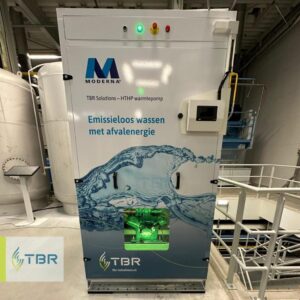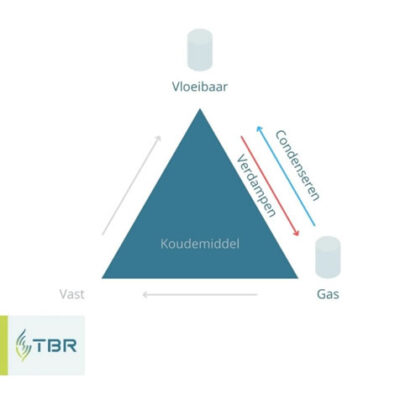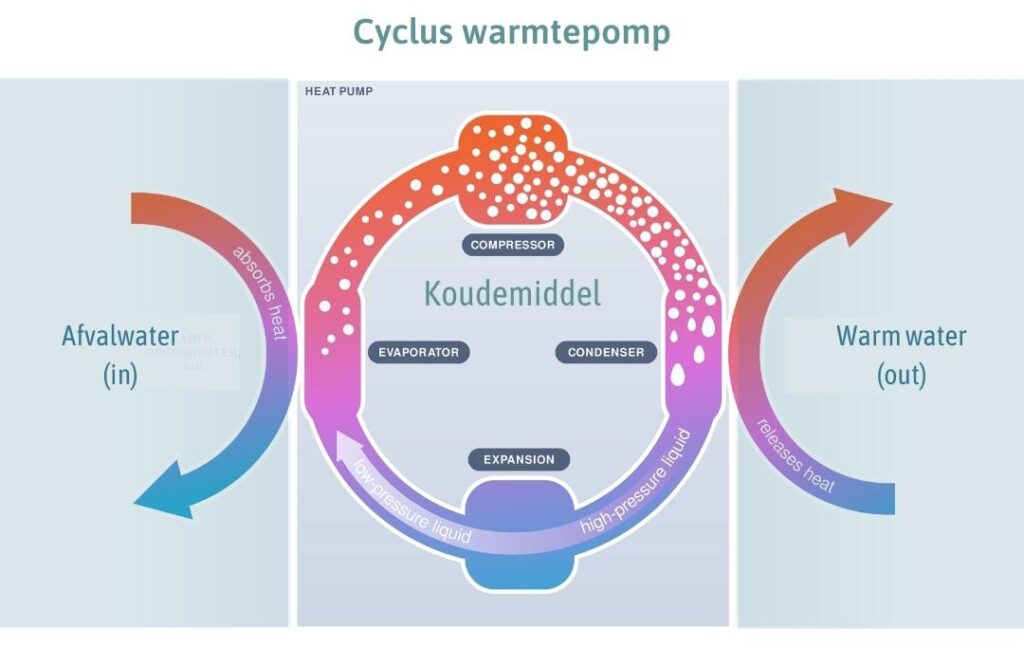Technical operation heat pump
A heat pump is a sustainable energy-saving alternative for heating water in, for example, a cleaning process. The CO2 emissions when heating by means of a heat pump is zero when this energy is extracted from a waste stream.

How does a heat pump work?
Heat pumps absorb heat and release it at a higher temperature level. A refrigerant (a liquid) circulates inside the heat pump, energy is continuously transferred through a compressor, a condenser, an expansion valve and an evaporator.
What does the refrigerant do in the heat pump?
In the heat pump we use refrigerants with a low boiling point as a medium for the transport of energy. Along there, we let a flow of waste energy flow; the source. This source energy is converted to a higher temperature and delivered to the offtake side of the Heat-X HTHP Heat Pump.

The 4 steps of the HTHP Heat Pump
The Heat-X HTHP Heat Pump works by evaporating a natural refrigerant (liquid) at a low temperature (1) and condensing the vapor at a high temperature (3). In the first case the boiling point must therefore be lowered and/or in the second case it must be increased.
The boiling point can be increased by increasing the pressure with a compressor (2). On the other hand, the boiling point can be lowered again by lowering the pressure in a turbine or throttle valve (4).
The whole of evaporation, compression, condensation and expansion forms a closed cycle for the circulating refrigerant, the thermodynamic cycle. But this does not apply to the heat and effort: net effort is added to the system in the compressor (electrical energy) and heat is transferred from the evaporator to the condenser. This transfers this heat at a higher temperature level to the incoming flow for the process.
Schematically this looks like this:

Applications for a heat pump
A heat pump is perhaps known for heating homes. At TBR Solutions we apply heat pump technology industrially. For example, we use waste energy as a source of energy, which is normally lost through the sewer or the roof. This residual energy is used to heat incoming water for the cleaning process.
You cannot simply use these waste streams as source energy. It is necessary to first make an inventory of what the current process looks like and what the consequences are for the entire process.
View the project where we apply the water pump in the laundry industry.
The refrigerant
Various refrigerants can be used in a heat pump. At TBR Solutions we opt for natural refrigerants. These have only a minor impact on the environment, unlike synthetic agents.
COP
The energy that drives the heat pump therefore yields the multiple of thermal energy. Each heat pump has its own performance. It depends on a number of factors including the input. We call this performance COP which stands for ‘Coefficient Of Performance’. With this number you indicate the ratio between the usable thermal heat obtained and the drive energy.
Efficiency Heat-X HTHP Heat Pump
The return is determined by pricing of fossil energy, electricity and subsidy options. In general we can say that:
- The payback period depends on a number of factors, but averages 5 years. When considering a steam boiler, this is even shorter, but who is going to consider a steam boiler with the current yields?
- CO2 emissions are reduced and pay attention: in 2030, the CO2 levy is expected to cost €125 per tonne of CO2! The HTHP gives a reduction of thousands of euros!
- The energy demand for the washing process is 100% recovered from waste energy.
- The performance of TBR’s HTHP heat pump has a performance COP (Coefficient Of Performance) of approximately 4.8 at higher temperatures! This means that with 1 kW input approximately 4.8 kW of thermal energy is released!
- It saves fossil fuels and reduces CO2 emissions
- The HTHP gives a high constant efficiency and a certain payback time compared to any other energy supply!
If you would like to know more about this technique, please contact:
 Henk Klatter,
Henk Klatter,
Project Engineer TBR Solutions
